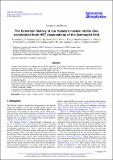Por favor, use este identificador para citar o enlazar a este item:
http://hdl.handle.net/10261/329886COMPARTIR / EXPORTAR:
 SHARE SHARE
 CORE
BASE CORE
BASE
|
|
| Visualizar otros formatos: MARC | Dublin Core | RDF | ORE | MODS | METS | DIDL | DATACITE | |

| Título: | The formation history of our Galaxy’s nuclear stellar disc constrained from HST observations of the Quintuplet field |
Autor: | Schödel, Rainer; Nogueras-Lara, F.; Hosek, M.; Do, T.; Lu, J.; Martínez-Arranz, Á.; Ghez, A.; Rich, R. M.; Gardini, A.; Gallego Cano, Eulalia; Cano-González, M.; Gallego Calvente, Teresa | Palabras clave: | Galaxy: center Galaxy: nucleus Galaxy: stellar content Galaxy: formation |
Fecha de publicación: | 14-abr-2023 | Editor: | EDP Sciences | Citación: | Astronomy & Astrophysics 672: L8 (2023) | Resumen: | Context. Until recently it was thought that the nuclear stellar disc at the centre of our Galaxy was formed via quasi-continuous star formation over billions of years. However, an analysis of GALACTICNUCLEUS survey data indicates that > 80% of the mass of the stellar disc formed at least 8 Gyr ago and about 5% roughly 1 Gyr ago. Aims. Our aim is to derive new constraints on the formation history of the nuclear stellar disc. Methods. We analysed a catalogue of HST/WFC3-IR observations of the Quintuplet cluster field. From this catalogue, we selected about 24 000 field stars that probably belong to the nuclear stellar disc. We used red clump giants to deredden the sample and fit the resulting F153M luminosity function with a linear combination of theoretical luminosity functions created from different stellar evolutionary models. Results. We find that ≳70% of the stellar population in the nuclear disc probably formed more than 10 Gyr ago, while ∼15% formed in an event (or series of events) ∼1 Gyr ago. Up to 10% of the stars appear to have formed in the past tens to hundreds of Myr. These results do not change significantly for reasonable variations in the assumed mean metallicity, sample selection, reddening correction, or stellar evolutionary models. Conclusions. We confirm previous work that changed the formation paradigm for stars in the Galactic Centre. The nuclear stellar disc is indeed a very old structure. There seems to have been little star formation activity between its formation and about 1 Gyr ago. © The Authors 2023. | Descripción: | This is an Open Access article, published by EDP Sciences, under the terms of the Creative Commons Attribution License (https://creativecommons.org/licenses/by/4.0), which permits unrestricted use, distribution, and reproduction in any medium, provided the original work is properly cited. | Versión del editor: | http://dx.doi.org/10.1051/0004-6361/202346335 | URI: | http://hdl.handle.net/10261/329886 | DOI: | 10.1051/0004-6361/202346335 | ISSN: | 0004-6361 | E-ISSN: | 1432-0746 |
| Aparece en las colecciones: | (IAA) Artículos |
Ficheros en este ítem:
| Fichero | Descripción | Tamaño | Formato | |
|---|---|---|---|---|
| 2023A&A...672L...8S.pdf | 19,19 MB | Adobe PDF |  Visualizar/Abrir |
CORE Recommender
SCOPUSTM
Citations
5
checked on 09-may-2024
WEB OF SCIENCETM
Citations
1
checked on 28-feb-2024
Page view(s)
19
checked on 16-may-2024
Download(s)
4
checked on 16-may-2024
Google ScholarTM
Check
Altmetric
Altmetric
Este item está licenciado bajo una Licencia Creative Commons

